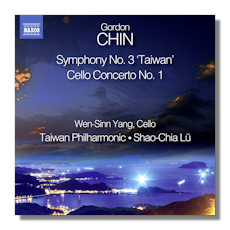
The Internet's Premier Classical Music Source
Related Links
- Latest Reviews
- More Reviews
-
By Composer
-
Collections
DVD & Blu-ray
Books
Concert Reviews
Articles/Interviews
Software
Audio
Search Amazon
Recommended Links
Site News
 CD Review
CD Review
Gordon Chin

- Symphony #3 "Taiwan"
- Cello Concerto #1
Wenn-Sinn Yang, cello
Taiwan Philharmonic Orchestra/Shao-Chia Lü
Naxos 8.570615 62:12
Gordon Chin (b. 1957) is one of Taiwan's leading composers: his output includes four symphonies, concertos for piano, violin and cello, choral and chamber works, and smaller instrumental pieces. Chin also serves as conductor of the Taipei-based Yin-Qi Symphony Orchestra and Chorus, and is on the faculty of the National Taiwan Normal University. He studied composition at the Eastman School of Music under Samuel Adler and Christopher Rouse. If I can judge Chin's style by the two works on this disc, I would say his music is tonal and fairly approachable, perhaps a couple of levels more challenging to the ear than Prokofiev or Bartok. If you're familiar with some of the later symphonies of Peter Mennin, you might find his idiom, different though it is stylistically from that American composer's, quite to your liking. In both works Chin uses many colorful or exotic percussion effects, some having an Asian character. I should mention here that Chin seems to have a very special way with percussion scoring in general, not a surprising trait for a composer who has written five percussion quartets!
The Cello Concerto (2006) opens the CD and is the longer work, with a duration of 35:44, compared with the symphony's 26:28. But length, of course, doesn't necessarily yield quality. That said, the concerto is a fairly strong composition, arguably worth its extended timing. The theme introduced by the cello in the first movement, coming just after emphatic opening chords from the orchestra, reminds me a bit of the main theme in Vaughan Williams' Flos Campi. But the two works are otherwise quite different even if they share an austere character. The whole first movement is rather dour with many tense exchanges between orchestra and soloist and a mixture of both slow and fast music. The second movement, subtitled Dreams trapped inside the Mirror, begins with a fast rhythmic idea, and alternates that music with the rather ethereal moods introduced by the cello. There is an interesting effects-laden central cadenza for cello based on the rhythmic theme. The finale, After the Great Pain, opens in a lively, restless mood, but eventually mixes in some slow music. The main theme from the first movement is recalled after which the cello plays in a sort of drunken and depressed manner, its tones fading and wavering. The ending is rather hysterical and puzzling: the orchestra, dominated by percussion, seems to roil and scramble in dread and the cello races along in its upper ranges in the same desperate manner, the concerto then ending as if fleeing (finally breaking free?) from some sinister force.
The Symphony #3 (1996), subtitled Taiwan, exists in the same kind of dark world but is a little more exotic in its scoring, also perhaps a little more difficult in its expressive language. A similar sense of churning and unrest appears in the first movement of the symphony, which is subtitled Plunder, and that movement ends with many issues unresolved. According to the composer in the album notes, the music "depicts the various invasions by foreign powers and the inevitable result of the feeling of helplessness of the people" of Taiwan. The first movement's music includes several motives: two representing Plunder and one for Crying for Help. The second movement, Dark Night, is lyrical and mostly subdued at the outset, and uses the melody from the Taiwanese folk song Flowers in the Rainy Night. The music grows more intense in the interior portions, again leaving a sense of unrest at the conclusion. The finale, Upsurge, depicts the heroic struggle of the Taiwanese people via the Struggle and Upsurge motives. It also recalls the Crying for Help motive and other material from the opening movement. The symphony ends in a sort of defiant triumph.
The performances by the Taiwan Philharmonic under Shao-Chia Lü are spirited and fully committed, and the cello soloist, Wenn-Sinn Yang, plays brilliantly and with great feeling in the concerto. Yang captured first prize at the 1991 Geneva Music Competition and served as the principal cellist with the Bavarian Radio SO from 1989-2005. These are premiere recordings of works by a composer of more than passing significance. The sound reproduction by Naxos is excellent. Those with an interest in late 20th and early 21st century music of an approachable character should find this disc satisfying.
Copyright © 2015, Robert Cummings





















